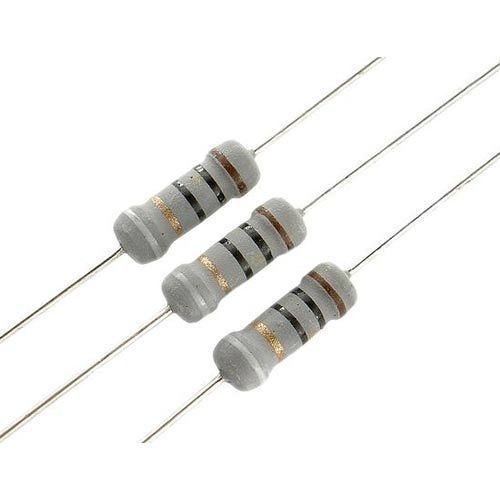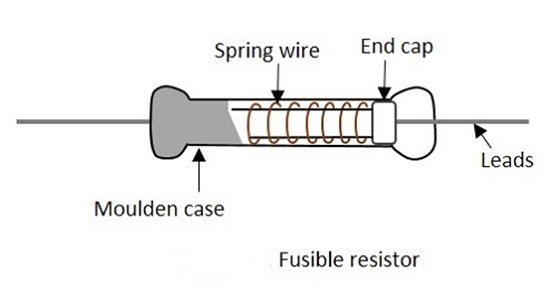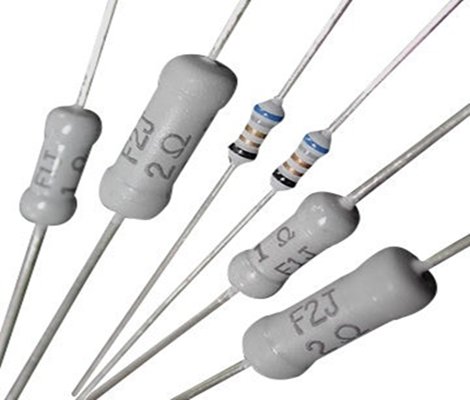Fusible Resistor or Fuse Resistor
What is a fusible resistor
The fusible resistor is a special type of resistor made to protect any circuit. It is made of a material that can fuse without flames or excess heat generation when the current load jumps suddenly more than required. Normally, in any circuit, this resistor looks rough and bigger in size and does not have the Smoothness and shine of the normal resistor. This resistor is always connected in series with the input main power supply to the circuit.
A fusible resistor is useful for highly sensitive circuits of lower power requirements and applications where the overload and surge handling requirements are not too severe. When any components of that circuit get faulty and change their behavior out of design property, then it may be that there is a fluctuation of current load change and, like, short circuit condition (not fully shorted). In this situation, other components of the circuit can get damaged easily, or excess heat and flames can destroy the whole system of the device. The fusible resistor provides a guarantee of the safety of the whole circuitry by fusing itself quickly.
Generally, any fusible resistor is manufactured of between very little value like 10Ω to 100Ω, and these values are used accordingly to the required circuit. Wirewound-type fusible resistors are mostly used.
Difference between a fuse and a fusible resistor.
A fusible resistor acts as a safety fuse, but there is a difference between a fuse and a fusible resistor.
A normal glass tube fuse is used where high surge current load devices are used like 2A, 8A, 10A, etc and this will burn when high load occurs according to fuse capacity or when short connection.
The fusible resistor used in the circuit operates at high voltage with small or lower currents such as 100ma, 250ma. A fusible resistor can pass the pulse of a high voltage like 500v without failure, but it must fuse quickly without flames when a 100v short circuit overloads.
Note – If any Fuse resistor is fused in any circuit, It denotes there is a fault in any component. Generally, in this case, one or two components are shorted by burnt. If you get shorted the fuse resistor through wire, then the a high risk of damaging other components
So, first, check the other components of that circuit carefully and change them before changing or shorting the fuse resistor. If any components did not get fully damaged but some of their property changed, then also fuse resistor will be fused again and again.
FAQ(frequently asked questions) – Fusible Resistor
Q: What is a fusible resistor?
A: A fusible resistor, also known as a fuse resistor or a fusing resistor, is a type of resistor that is designed to act as both a current-limiting resistor and a fuse. It is constructed with a special element or material that is intended to melt or open when subjected to excessive current or power dissipation.
Q: How does a fusible resistor work?
A: A fusible resistor is constructed with a low-melting-point material or a fuse wire embedded within the resistor body. Under normal operating conditions, the resistor functions as a regular current-limiting resistor, dissipating power and maintaining the desired resistance value. However, if the current exceeds a specified threshold or the power dissipation becomes excessive, the fuse element inside the resistor melts or opens, effectively breaking the circuit and protecting other components from damage.
Q: What are the advantages of using fusible resistors?
A: Fusible resistors provide combined functionality of current-limiting resistors and fuses, offering the following advantages:
- Overcurrent protection: They protect sensitive components and circuits from damage due to excessive current.
- Space-saving: Combining a resistor and a fuse into a single component saves space on the PCB.
- Cost-effective: Eliminates the need for separate fuses or additional circuit protection components.
- Easy replacement: When the fusible resistor blows, it is easily identifiable and replaceable.
Q: What are the applications of fusible resistors?
A: Fusible resistors are commonly used in various electronic circuits and devices, including:
- Power supplies: They protect power supply circuits from overcurrent situations.
- Automotive electronics: Used for circuit protection in automotive applications.
- Consumer electronics: Protects devices such as televisions, audio equipment, and home appliances.
- Industrial equipment: Used for circuit protection in industrial machinery and equipment.
- Printed Circuit Boards (PCBs): Fusible resistors are often used in PCBs as a space-saving measure.
Q: How are fusible resistors rated?
A: Fusible resistors are rated based on their resistance value, power rating, and the current or time required to cause the fuse element to blow. It is important to choose a fusible resistor with the appropriate ratings to ensure proper protection.
Q: Can fusible resistors be reset or reused once blown?
A: No, once a fusible resistor blows and the fuse element melts or opens, it cannot be reset or reused. The resistor should be replaced with a new one to restore its functionality.
Q: Are fusible resistors the same as regular fuses?
A: No, fusible resistors are different from regular fuses. Regular fuses are standalone components that are designed solely for circuit protection, while fusible resistors combine the functions of a resistor and a fuse into a single component.
Q: Are fusible resistors suitable for high-precision applications?
A: Fusible resistors may not be suitable for high-precision applications due to their tolerance and the potential for variation in resistance after the fuse element has blown. In such applications, specialized precision resistors may be preferred.
Q: Can fusible resistors be used as a deliberate weak point in circuit design?
A: Yes, fusible resistors can be intentionally used as weak points in circuit design to protect specific components or sections of a circuit. By carefully selecting the resistance value and the rating of the fusible resistor, it can serve as a sacrificial element that breaks the circuit and prevents damage to more critical components.
Also read
-
Switch ON Delay Timer circuit
-
What is Opto-coupler/opto-Isolator
-
Siren Sound, Bird Sound, Tone generator using 555 timer
-
Arduino Remote control AC Dimmer
-
Stabilizer Circuit Diagram
-
Variable Current and voltage supply 1.5v-30v and 0-10A




Thanks for explaining the concept of fusible resistors in a clear and concise manner. I now have a better understanding of how they work and their importance in safeguarding electronic circuits. Great post!
Thank you for explaining fusible resistors in such a clear way! I had always been curious about their function and how they differ from regular resistors. Your examples really helped to illustrate their importance in circuit protection. Looking forward to more insights on components like these!